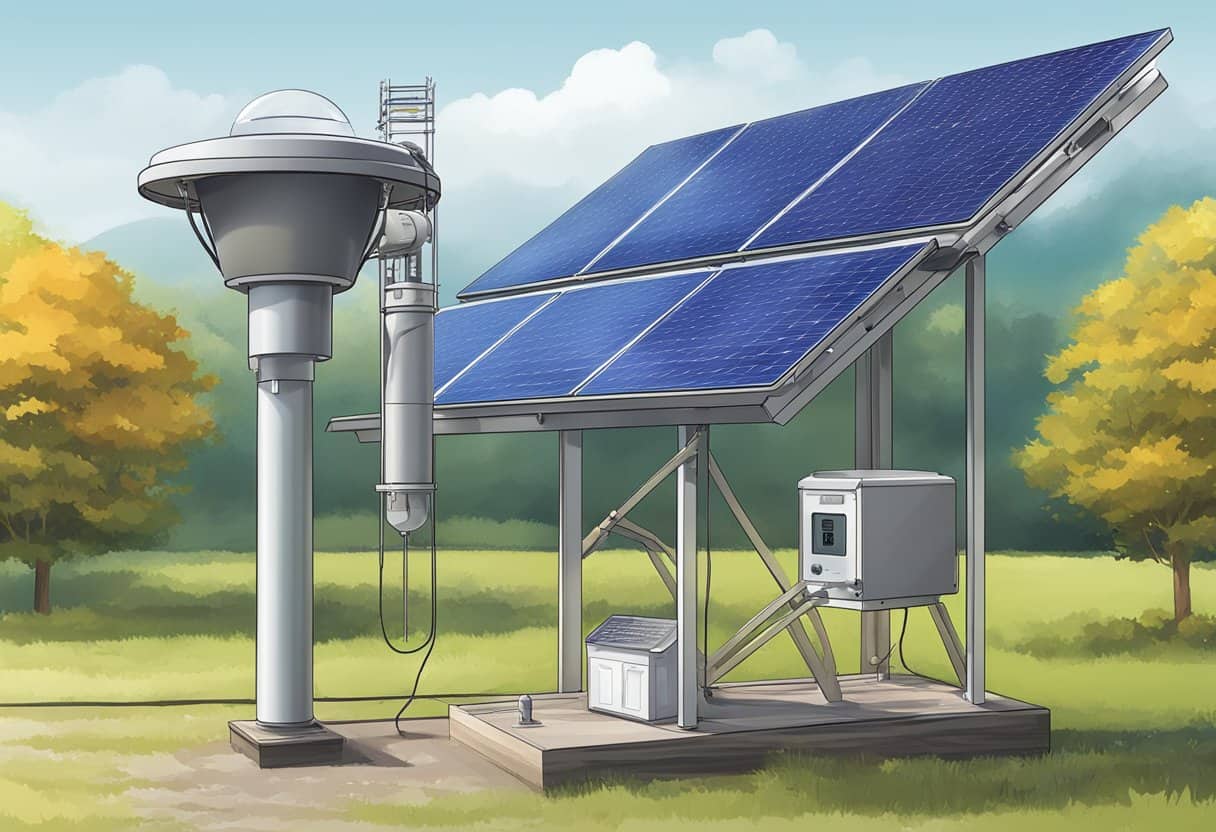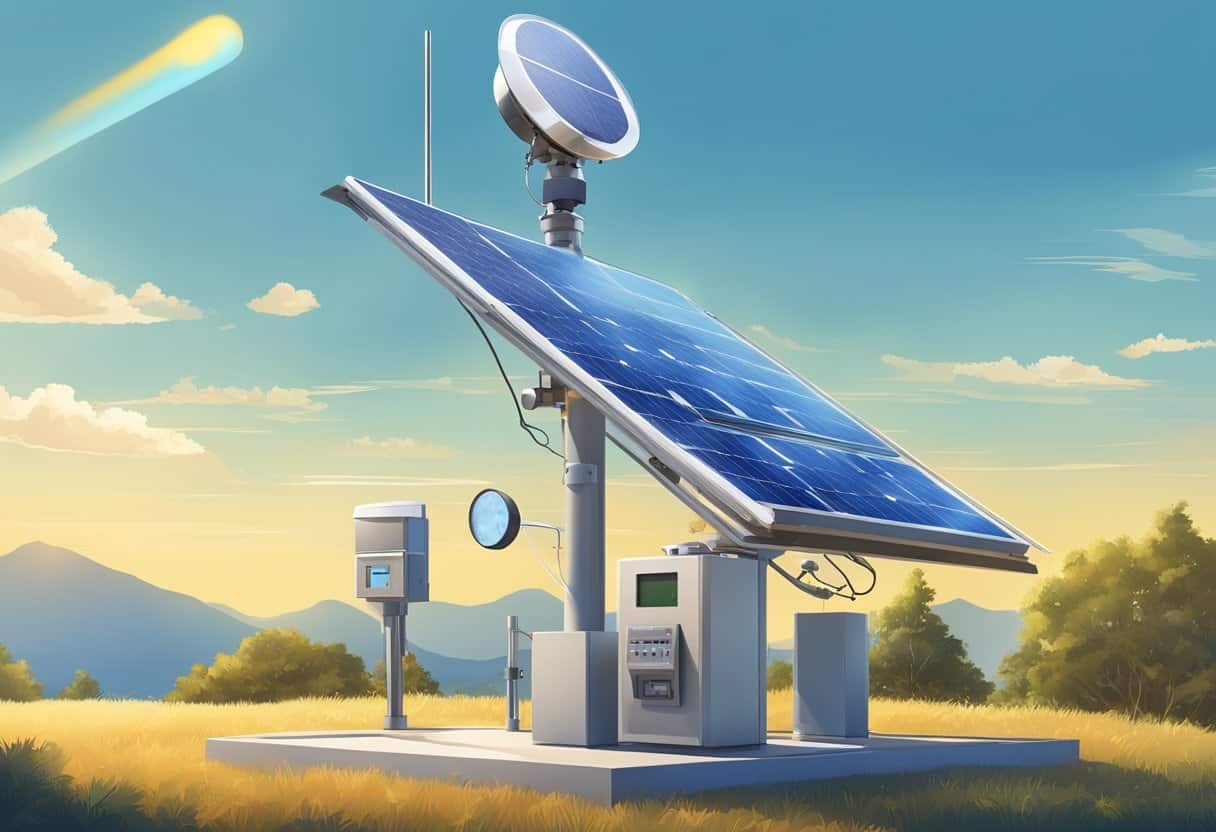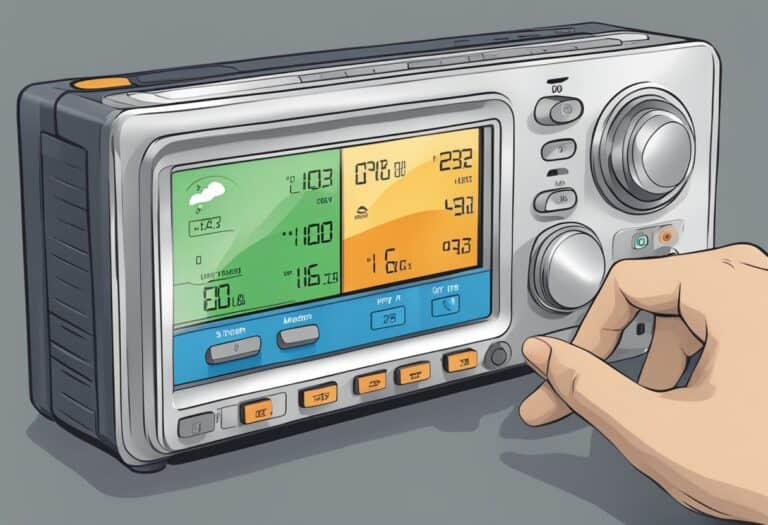Weather plays a crucial role in our daily lives, influencing everything from wardrobe choices to outdoor activities.
With the advent of solar-powered weather stations, you can now easily capture and analyze weather data customized to your local environment. Harnessing the sun’s energy, these devices offer a sustainable and efficient way to keep tabs on weather patterns, providing clarity about local weather conditions without the need for external power sources.
By integrating solar-powered weather stations into your routine, you’re able to monitor conditions with greater precision, making informed decisions about your day. These devices not only offer vital statistics on weather elements but also contribute to the ambience of your garden or balcony, serving as a bridge between technology and nature.
Whether you’re a gardening enthusiast, an outdoor sports aficionado, or simply enjoy being prepared for Mother Nature’s whims, a solar-powered weather station can enrich your life with real-time weather insights.
Sun-powered smarts! Ditch bulky cables & embrace sleek solar weather stations. Real-time temp, humidity, wind & more, right in your backyard. Track sunrise, plan outdoor adventures, even adjust your smart home based on weather forecasts. Sustainable, accurate, & oh-so-convenient – weather wisdom at your fingertips, powered by the sun!
Essential Features of Solar Powered Weather Stations
Choosing a solar powered weather station involves considering various key features to ensure reliable and accurate weather monitoring. These stations are equipped with advanced technology to measure a variety of weather variables, maintain power effectively, and integrate with your smart home systems.
Measuring Weather Variables
Your solar powered weather station should have a comprehensive sensor suite capable of measuring temperature, humidity, UV index, solar radiation, wind speed, wind direction, and rainfall. Accuracy is paramount, so look for stations with a radiation shield and high-quality sensors for consistent and precise data. Monitors should also cover atmospheric conditions like barometric pressure, dew point, heat index, wind chill, and possibly moon phase.
- Temperature and Humidity: Vital for assessing climate conditions.
- Rain Gauge: Measures rainfall, a critical component for tracking precipitation.
- Anemometer: Records wind speed and wind direction.
- UV/Solar Radiation Sensors: Evaluate the intensity of the sun’s rays.
- Barometric Pressure: Essential for forecasting weather changes.
Power Management and Backup Solutions
Solar powered weather stations harness energy from solar panels during daylight, but they also require a reliable backup power system for optimal performance 24/7. Ensure your weather station has a robust internal battery capable of maintaining operation through the night or during extended periods of low sunlight.
- Solar Panels: Primary power source, converting sunlight into electricity.
- Batteries: Serve as backup power to the solar panels.
- Power Management: Intelligent systems that manage battery power and operating temperature range for efficiency and durability.
Connectivity and Smart Home Integration
Connectivity is crucial for remote monitoring and data access. A top-notch solar powered weather station should offer wireless transmission to relay data to your devices. Smart home integration allows you to connect with other home automation systems, and internet connectivity ensures you can track your station’s data from anywhere.
- LCD/LED Display: For easy reading of real-time data.
- Internet: Enables access to your station’s data remotely.
- Smart Home Compatibility: Seamlessly connects with other home devices for an integrated home environment.
By focusing on these essential features, your solar powered weather station will deliver accurate data and reliable performance, keeping you informed about the latest weather conditions around your home.
Top Solar Powered Weather Station Brands
When looking for a solar powered weather station, you want reliability, accuracy, and ease of integration with your phone. The market has a variety of options, with brands like Ambient Weather, AcuRite, and Davis Instruments standing out for their innovative products.
Ambient Weather and Their Signature Models
Ambient Weather offers a range of models, with the Ambient Weather WS-2902 being a top choice. It’s a comprehensive home weather station that provides real-time weather updates directly to your phone. The Ambient Weather WS-2000 is another excellent model, perfect for those who want in-depth weather data at their fingertips.
AcuRite’s Innovative Home Weather Solutions
AcuRite is known for user-friendly home weather stations, such as the AcuRite Iris. These stations are praised for their easy setup and clear displays. AcuRite emphasizes connectivity, allowing you to monitor your local weather conditions from anywhere.
Davis Instruments’ Professional Grade Stations
For professional-grade accuracy, look to Davis Instruments. Their Vantage Vue and Vantage Pro2 stations are lauded by weather enthusiasts for their robust sensors and reliable performance. The Tempest Weather System is another high-quality product, offering cutting-edge weather tracking technology.
Installation and Maintenance Guidelines

When setting up your solar-powered weather station, ensuring proper installation and regular maintenance is essential to achieve long-term accuracy and functionality. Pay close attention to factors such as location, exposure to elements, and compatibility with home automation systems.
Setting Up Your Home Weather Station
Begin by identifying a location that receives ample direct sunlight to power the solar panel effectively. Avoid shaded areas where buildings or trees might obstruct sunlight. Your solar weather station’s panel should be positioned to maximize exposure to the sun during peak hours.
Mount the weather station onto a mounting pole securely using the provided mounting bracket and screws. Assure the construction is stable to withstand high winds or lightning strikes. The wind vane and anemometer should be placed high enough to avoid obstructions that could interfere with wind gust measurements.
For those with smart homes, ensure that your weather station is compatible with Alexa or Google Home for seamless integration. The indoor console, which often includes an LCD screen, should be set up in a convenient location within your home to view and interpret the data collected by the station.
Achieving Accurate Measurements and Longevity
To maintain accuracy, check that components like the wind vane and anemometer are free from obstructions and secured against corrosion. Use materials or coatings that are eco-friendly and designed to last in harsh weather conditions when performing routine maintenance.
Replace the rechargeable battery regularly to ensure it holds a charge effectively. Some stations come equipped with a supercapacitor for added reliability. Keep an eye on the battery level through the indoor console and replace it when necessary.
Regularly clean the solar panel to keep it free of dust and debris, which may impact the efficiency of sunlight absorption. When following a buying guide for solar weather stations, look for models that offer easy-access panels for cleaning and maintenance.
Ensure each component, from the screws and poles to the sensors, is checked often for signs of wear and tear to avoid sudden malfunctions or inaccurate readings.
Integrating Weather Data into Daily Life
Weather data plays a vital role in helping you plan and optimize your daily routines. With advancements in technology, integrating this data into daily life has become a seamless experience, providing actionable insights for both outdoor adventures and indoor living.
Utilizing Weather Forecasts for Outdoor Activities
Before stepping outside, check your personal weather station that’s been efficiently powered by solar panels. These stations can provide hyper-local weather readings such as outdoor temperature, wind chill, and even the heat index, which are crucial for outdoor enthusiasts. If you’re planning to garden, a soil moisture sensor can inform you when it’s the ideal time to water your plants, maximizing the effectiveness of your efforts.
- Sunrise and Sunset: Perfect for photographers and hikers, know precisely when daylight begins and ends.
- Wind Chill and Heat Index: These alerts help you dress appropriately for your run or cycling session.
- Customizable Alerts: Set up alerts on your device for sudden weather changes like thunderstorms that might interrupt your outdoor plans.
Smart Alerts and Functions for Indoor Comfort
Inside your home, integrate smart home technology for a comfortable environment, adjusting settings based on weather updates from your stations. Ensure your home’s indoor temperature is always ideal with smart technology, which adjusts your heating or cooling systems based on indoor sensors and ambient weather data.
- Wi-Fi Connectivity: Connect your weather stations to the internet for real-time updates on your smartphone or smart display.
- Additional Sensors: Deploy sensors for dew point or capacitors storing solar power for nighttime usage.
- Moon Phase: For a peaceful sleep, some stations provide moon phase data to help you understand the lunar cycle, complementing your knowledge of the natural world.
By harnessing solar panels and batteries to operate your devices, combined with smart technology, you can ensure continuous monitoring and gain precise weather forecasts that adapt to the sunlight or lack thereof. Use these devices to make informed decisions, from planning your day around the peak daylight hours to setting a reminder for when to bring the pets in before the sunset. With customizable alerts, you’re always one step ahead, ensuring that your daily activities are aligned with the rhythms of the weather.
Frequently Asked Questions
When exploring the benefits of renewable energy sources in weather monitoring, solar-powered weather stations stand out for their efficiency and sustainability. Here, we answer the most common questions to guide you in selecting the most suitable solar-powered weather station for your needs.
What are the top solar-powered weather stations available on the market?
Among the best weather stations, products like the Davis Vantage Pro2 and the Ambient Weather WS-2000 are highly regarded for their accuracy, durability, and range of features. They offer comprehensive data collection, from temperature to wind speed, all powered by clean solar energy.
How do solar-powered weather stations compare to traditional weather stations?
Solar-powered weather stations operate with fewer constraints than traditional stations since they do not depend on grid power. They are sustainable, reducing the need for replaceable batteries, and are particularly advantageous in areas where consistent electricity service is a challenge. Their increased autonomy makes them a robust alternative to conventional weather stations.
What features should one look for in a high-quality solar-powered weather station?
Key features for a top-notch solar-powered weather station include a high-capacity solar panel, backup battery system, real-time data transmission, and a comprehensive sensor suite capable of measuring parameters such as humidity, temperature, wind speed, and solar radiation. Selecting a model with a strong wireless range is also critical for data consistency.
Can solar-powered weather stations be used off-grid and how reliable are they in remote locations?
Solar-powered weather stations excel in off-grid and remote locations due to their independence from external power sources and ability to harness sunlight. Their reliability is often demonstrated through rigorous testing under varied environmental conditions, ensuring accurate data collection even in the most secluded areas.
What are the benefits of using a solar-powered weather station for home use?
For home use, these stations offer the advantage of real-time weather monitoring without the ongoing cost of electricity or battery replacements. They often come with easy-to-use interfaces and can be integrated with home automation systems, making them a practical addition for those interested in climate-conscious living and home gardening projects.
Which professional solar-powered weather stations are recommended for agricultural purposes like farming?
Professionals in agriculture may opt for stations like the RainWise AgroMET, known for its robust construction and precision agriculture features. Such stations help in effectively managing water resources and optimizing crop yields by providing critical data required for informed decision-making and are a long-term investment in sustainability.







